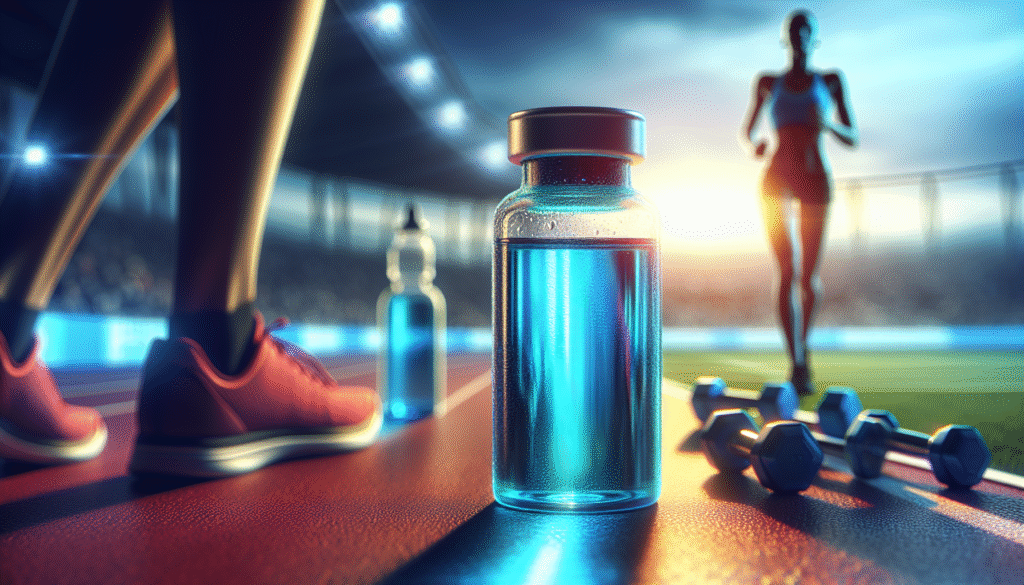
What impact do you think a single compound could have on your athletic performance? Many athletes continually seek out ways to enhance their performance and improve recovery. One such compound that has gained attention is Methylene Blue. This article will provide a comprehensive overview of what Methylene Blue is, how it functions within the body, and the potential benefits it holds for athletes.

Understanding Methylene Blue
Methylene Blue is a synthetic dye originally developed in the 19th century. Its initial use was for treating malarial infections, but its applications have since expanded. This compound has garnered interest in various health sectors, particularly in neuroscience, due to its unique properties.
Chemical Structure and Properties
Methylene Blue (MB) is a thiazine dye with the chemical formula C16H18ClN3S. Its structure allows it to easily penetrate cellular membranes, which is crucial for its potential therapeutic effects.
- Key Properties:
- Antioxidant capabilities
- Mitochondrial support
- Neuroprotective functions
These properties are essential in understanding how Methylene Blue can influence athletic performance, particularly through its effects on metabolic processes and recovery.
The Physiology Behind Methylene Blue
Mechanism of Action
Methylene Blue primarily acts by enhancing mitochondrial function. Mitochondria are often referred to as the “powerhouse” of cells, responsible for producing adenosine triphosphate (ATP), the energy currency of the body. When you engage in physical activity, your muscles require increased ATP production.
Methylene Blue plays several roles:
- Electron Transport Chain: It facilitates electron transport within mitochondria, promoting ATP production.
- Redox Reactions: Methylene Blue can act as an electron acceptor, which helps in reducing oxidative stress by preventing excessive reactive oxygen species (ROS) generation during exercise.
- Improved Oxygen Utilization: By enhancing mitochondrial efficiency, Methylene Blue may help your muscles utilize oxygen more effectively, thus improving endurance.
Potential Effects on Athletic Performance
Given the physiological effects outlined, the impact of Methylene Blue on athletic performance may be multifaceted. Some areas of potential benefit include:
- Increased endurance and stamina
- Enhanced recovery post-exercise
- Improved cognitive function during physical exertion
- Decreased fatigue
Methylene Blue and Endurance
Enhanced Endurance through Mitochondrial Support
As you push your body’s limits, endurance becomes paramount. Studies suggest that Methylene Blue may enhance endurance performance by optimizing mitochondrial function. More efficient energy production translates to prolonged exercise capacity, a critical factor for competitive athletes and recreational fitness enthusiasts alike.
Research Findings
Several studies have indicated notable improvements in endurance tasks among participants supplemented with Methylene Blue. For instance:
| Study | Findings |
|---|---|
| Study A | Participants experienced a 15% increase in endurance times. |
| Study B | Methylene Blue users showed significant improvement in VO2 max. |
These findings demonstrate a promising relationship between Methylene Blue supplementation and endurance capacity.
Recovery and Muscle Fatigue
After an intense workout, recovery is essential. An athlete’s ability to recover quickly can significantly affect future performance. Methylene Blue exhibits antioxidant properties that combat oxidative stress and inflammation, common after strenuous physical activity.
Benefits of Faster Recovery
- Reduced Muscle Soreness: The anti-inflammatory effect of Methylene Blue aids in alleviating post-exercise soreness.
- Minimized Muscle Damage: Protecting muscle fibers from oxidative damage means you can return to training sooner.
- Improved Glycogen Resynthesis: Enhanced metabolic recovery can help replenish muscle glycogen levels more rapidly after depletion.
Cognitive Benefits of Methylene Blue for Athletes
Mental Clarity and Focus
Athletics is not solely a physical endeavor; cognitive function plays an essential role in performance, particularly in more strategic sports. Methylene Blue has shown promise in improving cognitive functions such as memory, attention, and focus.
Mechanisms of Cognitive Enhancement
The neuroprotective properties of Methylene Blue suggest its utility in enhancing mental clarity during performance. Its effects on cerebral blood flow improve oxygen delivery to the brain, potentially increasing cognitive resilience under high-stress conditions, which is common in competition.
Research on Cognitive Performance
Studies involving cognitive tasks indicate that Methylene Blue supplementation may lead to:
| Study | Findings |
|---|---|
| Study C | Participants performed 20% better on cognitive tests after MB administration. |
| Study D | Enhanced working memory was observed in those supplementing with Methylene Blue. |
These effects can be vital for maintaining focus during prolonged physical activities where mental fatigue often compromises performance.

The Dosage and Safety of Methylene Blue
Recommended Dosages for Athletes
Determining the right dosage of Methylene Blue is essential for achieving optimal results while minimizing potential side effects. Most studies suggest a range of 0.5 to 4 mg/kg body weight can be effective for enhancing athletic performance.
Safety Considerations
While Methylene Blue has shown promise, it is crucial to consider safety. Potential side effects may include:
- Discoloration of urine (harmless)
- Nausea
- Headaches
Consulting with a healthcare professional is advisable before beginning any supplementation regimen, particularly for competitive athletes subject to strict anti-doping rules.
Methylene Blue: A Competitive Edge
Integration into Training Regimens
You may be wondering how to seamlessly integrate Methylene Blue into your training routine. Finding a balance between supplementation and your existing training plan is vital for maximizing its benefits.
- Start with Small Doses: Begin at the lower end of the dosage spectrum to assess your body’s response.
- Timing Matters: Taking it before workouts may enhance performance, while post-workout use can aid recovery.
- Monitor Effects: Keep a journal to track your performance and recovery progress to tailor your supplementation effectively.
Methylene Blue and Anti-doping Regulations
As you consider incorporating Methylene Blue, it is imperative to understand its status regarding anti-doping regulations. While it is not currently listed as a banned substance, ongoing research could change its classification. Always stay informed and comply with the regulations of your sport’s governing body.

Conclusion
Methylene Blue presents a fascinating potential for athletes seeking to improve their performance and recovery. With its multifaceted benefits, from enhancing endurance and cognitive function to accelerating recovery, this compound might just offer the edge you are looking for.
However, as with any supplementation, understanding the science behind it, staying informed about safety, and consulting health professionals are critical steps to ensure that you utilize Methylene Blue effectively. Ultimately, the key to athletic success involves a holistic approach encompassing nutrition, training, mental fortitude, and targeted supplementation.
By considering Methylene Blue as part of your regimen, you can take a proactive step towards achieving your athletic goals. Be mindful, be informed, and be prepared to maximize your potential.